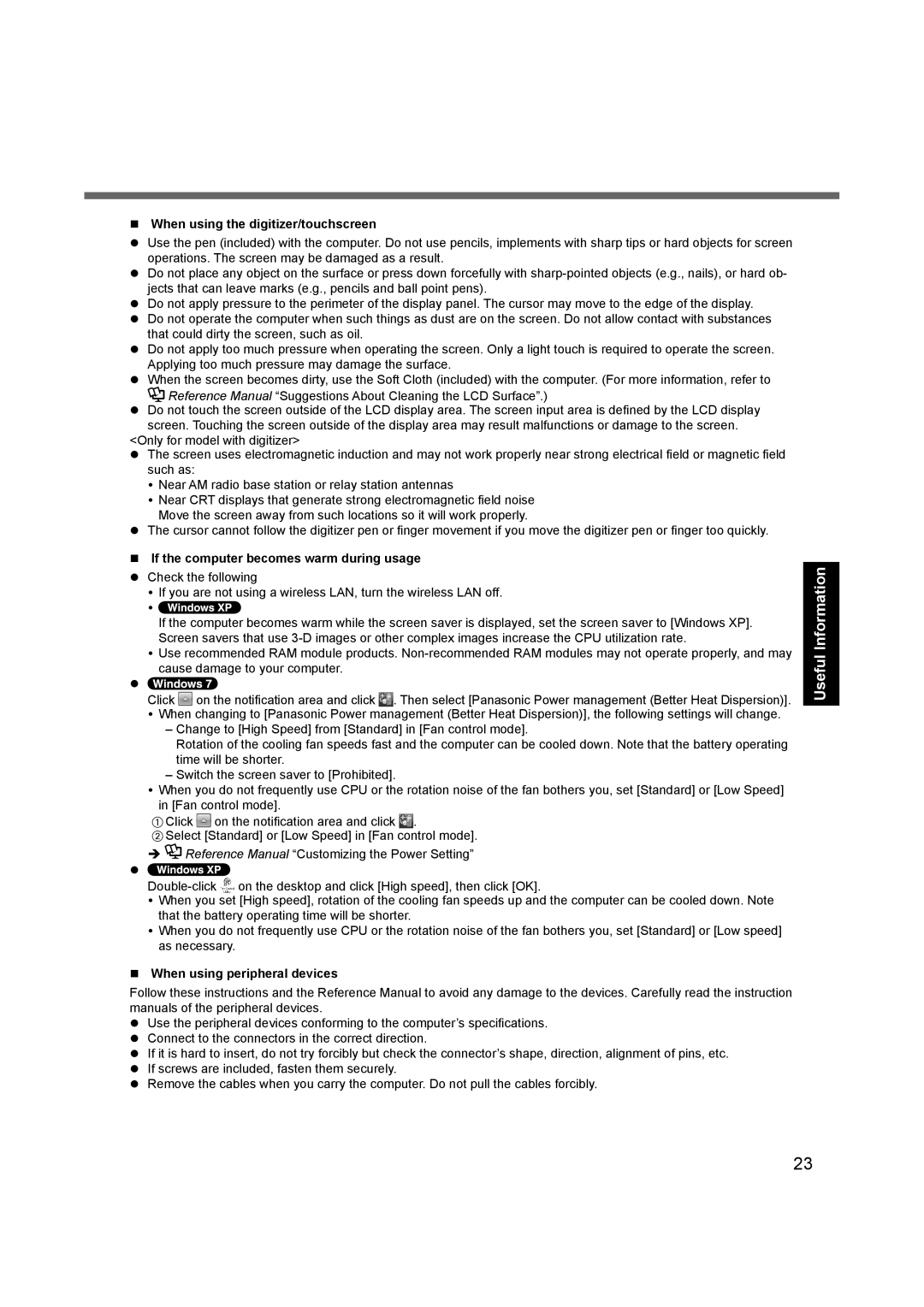
When using the digitizer/touchscreen
Use the pen (included) with the computer. Do not use pencils, implements with sharp tips or hard objects for screen operations. The screen may be damaged as a result.
Do not place any object on the surface or press down forcefully with
Do not apply pressure to the perimeter of the display panel. The cursor may move to the edge of the display. Do not operate the computer when such things as dust are on the screen. Do not allow contact with substances that could dirty the screen, such as oil.
Do not apply too much pressure when operating the screen. Only a light touch is required to operate the screen. Applying too much pressure may damage the surface.
When the screen becomes dirty, use the Soft Cloth (included) with the computer. (For more information, refer to
![]() Reference Manual “Suggestions About Cleaning the LCD Surface”.)
Reference Manual “Suggestions About Cleaning the LCD Surface”.)
Do not touch the screen outside of the LCD display area. The screen input area is defined by the LCD display screen. Touching the screen outside of the display area may result malfunctions or damage to the screen.
<Only for model with digitizer>
The screen uses electromagnetic induction and may not work properly near strong electrical field or magnetic field such as:
Near AM radio base station or relay station antennas
Near CRT displays that generate strong electromagnetic field noise Move the screen away from such locations so it will work properly.
The cursor cannot follow the digitizer pen or finger movement if you move the digitizer pen or finger too quickly.
If the computer becomes warm during usage
Check the following
If you are not using a wireless LAN, turn the wireless LAN off.
If the computer becomes warm while the screen saver is displayed, set the screen saver to [Windows XP]. Screen savers that use
Use recommended RAM module products.
Click ![]() on the notification area and click
on the notification area and click ![]() . Then select [Panasonic Power management (Better Heat Dispersion)]. When changing to [Panasonic Power management (Better Heat Dispersion)], the following settings will change.
. Then select [Panasonic Power management (Better Heat Dispersion)]. When changing to [Panasonic Power management (Better Heat Dispersion)], the following settings will change.
–Change to [High Speed] from [Standard] in [Fan control mode].
Rotation of the cooling fan speeds fast and the computer can be cooled down. Note that the battery operating time will be shorter.
–Switch the screen saver to [Prohibited].
When you do not frequently use CPU or the rotation noise of the fan bothers you, set [Standard] or [Low Speed] in [Fan control mode].
AClick ![]() on the notification area and click
on the notification area and click ![]() .
.
BSelect [Standard] or [Low Speed] in [Fan control mode]. ![]() Reference Manual “Customizing the Power Setting”
Reference Manual “Customizing the Power Setting”
![]() on the desktop and click [High speed], then click [OK].
on the desktop and click [High speed], then click [OK].
When you set [High speed], rotation of the cooling fan speeds up and the computer can be cooled down. Note that the battery operating time will be shorter.
When you do not frequently use CPU or the rotation noise of the fan bothers you, set [Standard] or [Low speed] as necessary.
When using peripheral devices
Follow these instructions and the Reference Manual to avoid any damage to the devices. Carefully read the instruction manuals of the peripheral devices.
Use the peripheral devices conforming to the computer’s specifications. Connect to the connectors in the correct direction.
If it is hard to insert, do not try forcibly but check the connector’s shape, direction, alignment of pins, etc. If screws are included, fasten them securely.
Remove the cables when you carry the computer. Do not pull the cables forcibly.
Useful Information
23
